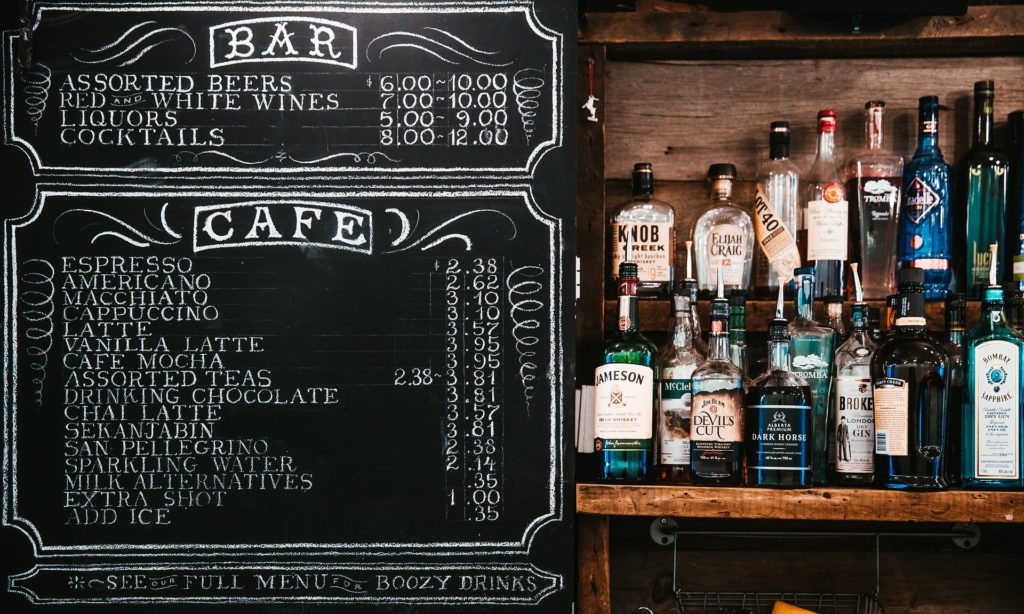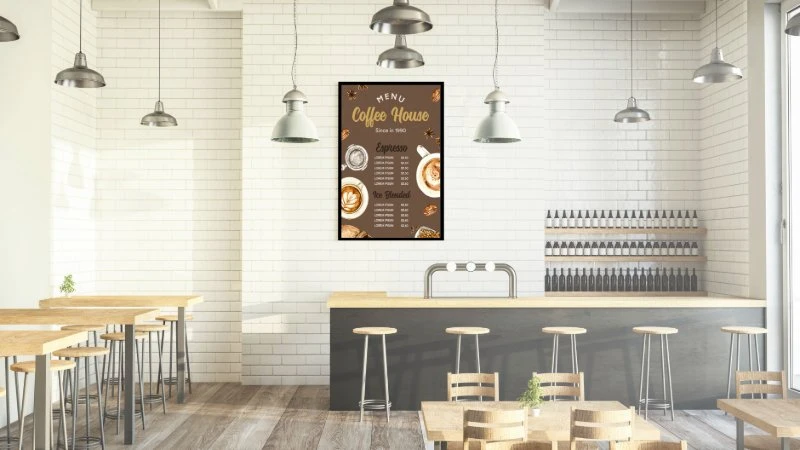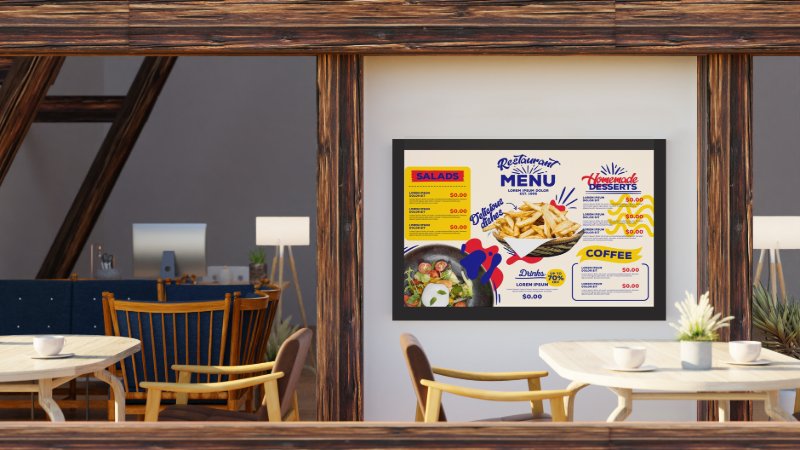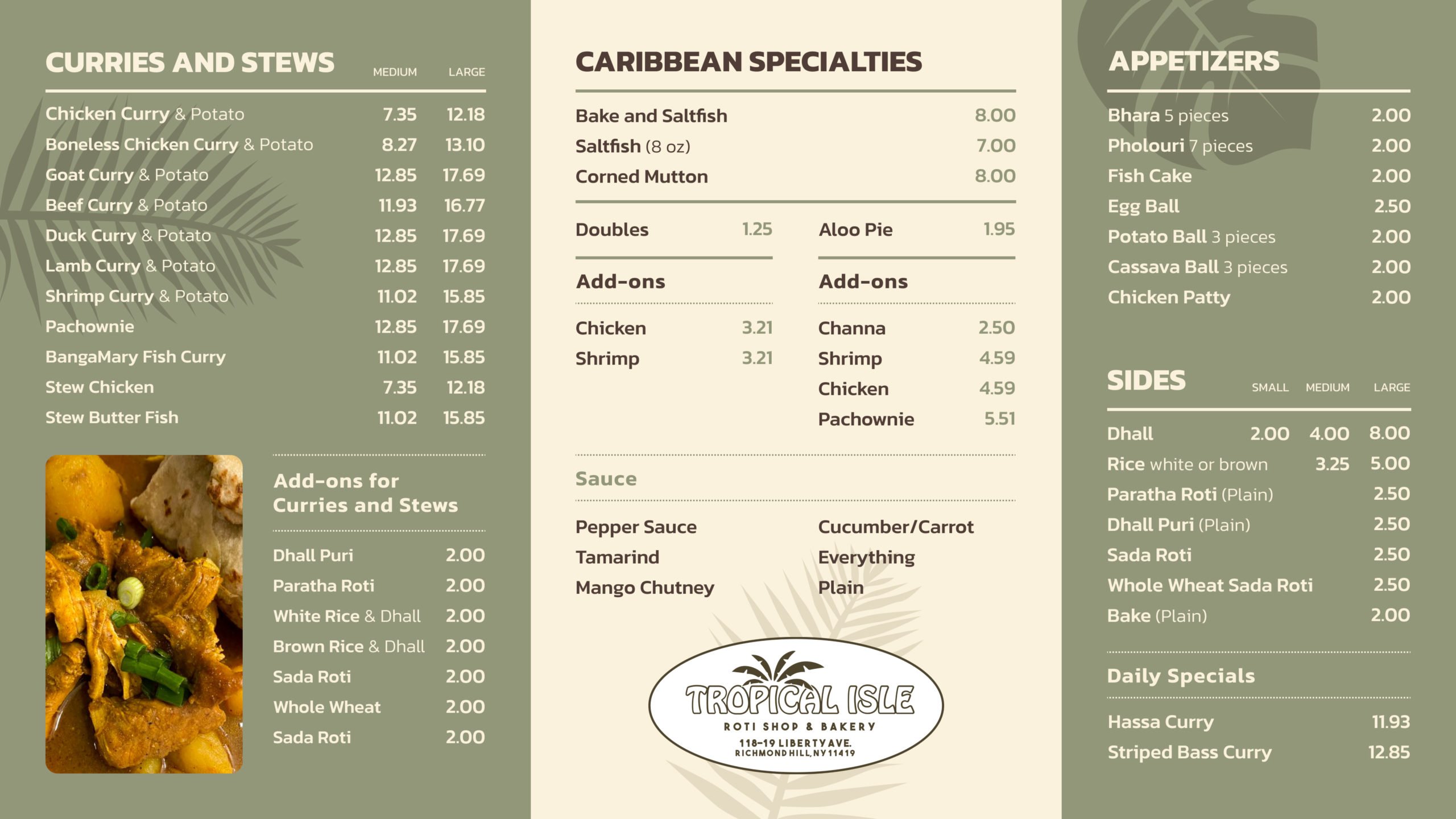What Menu Boards Can Your Restaurant Use?
Restaurant technology has become a competitive edge for restaurants all around the nation. Nowadays, 71% of consumers believe that restaurant technology has improved the client experience. Digital menu boards are one of the favorite restaurant technologies because they have succeeded in increasing sales, creating brand awareness, and lowering costs.
A digital menu board is an electronic screen that displays a restaurant’s meal selections. The boards are eye-catching and stimulating, which draw the attention of waiting clients. Moreover, a digital menu board lists all products, which include add-ons and popular combos to enable customers to know what they should order at the counter. Digital menu boards featuring items on a bright screen instead of physical menus are easier for customers to read than the latter option.
Traditional Menu Boards
Today, traditional menu boards are still widely used in restaurants for information and decoration. Some of the most popular traditional menu boards include the following.
- Paper Menus
Paper menus are a classic part of the dining culture. Most paper menus use colorful pictures, logos, and fonts to attract readers.
Static menus usually provide several sub-product categories that may include appetizers, desserts, sides, and entrees for readers to make choices based on their preferences. High-quality paper menus offer a personalized dining experience, as well as allowing customers to make informed decisions easily. However, printing paper menus is expensive, especially if you often have new products.
- Chalkboard

A chalkboard menu board is a restaurant’s DIY approach to menu presentation, where you write the daily menu on a chalkboard. These displays are usually placed at the front of eateries to attract passersby. Chalkboard menus are cheap to put up and convenient because you can introduce new designs and logos as often as needed.
- Banner Menu Board
A banner menu board is a large poster that hangs from the ceiling and displays food and beverage choices for patrons. These posters are typically displayed behind the checkout counter to trigger impulse purchases and promote certain products. But, just like paper menus, reprinting banner menus is costly.
Digital Menu Boards

Digital menu boards work by integrating software, hardware, and content, as described below.
- Hardware
A digital menu solution consists of a commercial-grade screen with rugged construction, anti-reflective coating, and enhanced brightness. These features keep your menu visible at all times and ensure your screen endures any harsh business environment.
- Media Player
It is also necessary to have a media player for the menu to display on the screen. The media player downloads content from the software and sends it to a screen via a Wi-Fi connection.
- Software
A content management software (CMS) displays content on a screen. The top-performing software provides zone layouts, scheduling, and day-parting functionality with easy media publishing as well as integration with many content apps.
- Content
Text, images, videos, animations, and graphics are what make up digital menus. The final step in setting up your digital menu board is creating a vibrant menu that will delight your audience and increase sales.
Applications of Digital Menu Boards
Digital menu boards can be used in a variety of ways, including the following.
- Introduce New Products
In case your business regularly introduces new products, digital signage is a necessary tool for the marketing team. Employ digital menu boards to show launch dates, highlight new products, and build up excitement.
- Run Promotions
One of the advantages offered by digital menu boards is dynamic pricing. With this feature, you can adjust prices on the fly and link promotional discounts to your inventory database.
- Upsell and Cross-Sell Items
Adding colorful pop-ups on digital boards makes it easy to cross/up-sell menu items. For instance, a restaurant could promote its value by selling combo meals such as fries and drinks. Besides, for a few dollars more, you can motivate your customers to order a larger portion.
- Improving Brand Awareness
Digital menu boards are a great way to enhance your brand image. Help customers remember your brand identity by using colors, fonts, logos, and images to beautify digital menus.
Benefits of Digital Menu Boards
Switching from traditional menu boards to digital menu boards offers many benefits, including:
- Increase Sales
Digital menu boards contribute to higher sales as they promote high-margin products and point out special deals. Moreover, beautiful graphics on brightly lit screens prompt spontaneous buying. In fact, 8 out of 10 viewers bought something they didn’t intend to buy after seeing a digital ad.
- Dynamic Content
What digital screens provide waiting customers with is dynamic content that can engage and motivate them. Animations, videos, and photos can bring your menu to life and give you an edge over your competitors.
- Real-time Updates
The limitation of printed menus is the fact that changes in menu items require printing new material, which takes time and money. In comparison, digital menu boards can be updated in real-time so that you are able to promote seasonal items as well as limited-time offers.
- Improving Customer Engagement
Static menus are becoming outdated as digital devices become the norm for customers. And that’s not all: visual content gets 94% more views than text information. So, restaurants should make use of digital screens to bring customers in.
LED Menu Boards
An LED Menu Board features an inbuilt LED panel through which the restaurant’s food menus are displayed. Before the introduction of LED menus, numerous establishments relied on fluorescent backlight systems. However, LED lighting is more energy efficient and needs less maintenance than conventional fluorescent lighting solutions.
Furthermore, the LED menu board provides high image quality and helps managers rotate food and drink images. Use vibrant animations to upsell and cross-sell, promote offers, and highlight new items. Finally, you can customize the color of your LED menu board to match your restaurant’s decor and brand identity to increase customer loyalty.
Interactive Menu Displays
Interactivity is one of the top trends in menu boards to increase customer engagement. At present, interactive content is twice as engaging when compared to static content. Hence, restaurant owners should think about using interactive displays to be unique.
An interactive menu board offers a touchscreen display whereby consumers can configure menus and place orders. Also, users can click on an item to find out more or subscribe to a loyalty program. Some of these interactive displays enable card payment, creating a seamless checkout process.
Mobile device integration feature is another exciting innovation, where patrons use their mobile phones to interact with digital displays through QR code integration. Lastly, artificial intelligence is another promising technology due to its ability to gather useful information from customer interactions with interactive displays.
Outdoor Menu Board
The outdoor menu board is a digital screen that stands outside a restaurant to display menus, promotions, and offers. These boards utilize high-quality photographs and videos to attract passerby’s attention as well as influence drive-thru options.

However, outdoor menu displays need weatherproof enclosures that are capable of standing up to extreme elements such as snow and rain. The screens should also have anti-reflective coatings and high brightness configurations to enable readability in direct daylight as well as at night.
Customizable Menu Board
With a customizable menu board, you can personalize the logo, background image, layout, language, colors, and font type.
The significance of customization lies in the fact that it helps to improve brand visibility and continuity. Secondly, customizable menu boards create opportunities for you to structure your meal options in a way that highlights desirable aspects such as popularity or pricing.
Choosing the Right Menu Board for Your Restaurant
Before installing a digital menu board in your restaurant, consider the following factors.
- Ambiance
A digital menu board that matches the look and feel of your facility promotes design consistency. Customizable options allow your digital menu board to blend into your restaurant’s décor.
- Target Customers
The content you display on your digital menu board will be determined by your target group. For example, a family restaurant might offer cartoons for children or a menu for the whole family.
- Cuisine
Before you start your digital menu board, list all the items you will offer and decide the best way to organize them on display. For example, you can group similar products to help customers make quick decisions.
Maintaining and Updating Menu Boards
Digital menu solutions require regular maintenance to avoid software issues, connectivity issues, and more. Therefore, if you invest in a digital board, set up a framework for regular maintenance to keep the system running smoothly. Additionally, train your staff on updates and maintenance to ensure the board is working properly.
Digital content also requires regular updates to make it attractive to the audience. When customers are constantly seeing the same content on a digital screen, they lose attention. Therefore, introduce new layouts, designs, images, and videos regularly.
Cost Considerations
As with any restaurant investment, you need to consider the cost and ROI of your digital menu board. The cost of a digital menu board includes the cost of hardware, software, media player, installation, content creation, and maintenance.
But on the bright side? You get your investment back by drawing more sales, impulse purchases, and promoting items with higher returns, it’s a win-win. In addition, data digital menus give insight as to which items are a hit, letting you play up your kitchen’s stars. Do away with printing costs for paper menus and go digital instead.
In Conclusion
Digital boards make menu items more appealing through vibrant images and animations. However, it’s not enough to simply install a digital menu board in your restaurant and hope for the best. To realize the full potential of digital signage technology, screens must be tailored to your brand identity, customer expectations, and mood.




